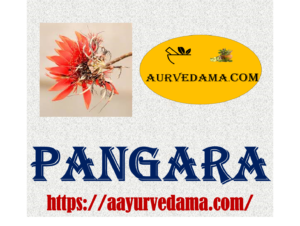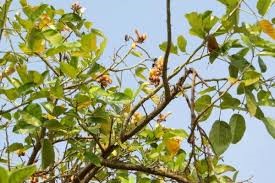Pangara
Pangara is an Ayurvedic medicinal plant that grows in India. It bears delicate, beautiful red flowers. This tree gives a green shawl when the foliage is green. Although the tree is not very important in our calculations, if we consider the usefulness of all its limbs, it becomes important. The bare-boiled Pangara, which bears red satin-like flowers without foliage, resembles a bare-limbed, red-faced pot king. These red flowers attract butterflies and birds because of their honey and we also stop for a moment to watch the game of this potraja. Pangara is a tropical forest tree. We have Pangara planted in the rocks in the forest, in the garden in the city, on the fence of the farm. A tea plantation is planted for shade. The distribution of this tree is especially in the deciduous and mixed forests of Konkan and North Karwar in the western peninsula. The journey of the wheel takes place in nature. Birds pollinate the bees by taking honey from the flowers. Seedlings are also formed by dropping the seeds in the pods held by it. Pangara also survives on branches. Pangara blooms with red attractive flowers without a single leaf on it. Although its flowers have no smell, their color charms our minds. Pangara flowers from February to April.

The red color of the flowers and the velvety petals make anyone look at you. Although it has thorns on its body, the green of this 50-60 feet tree leaves the sky with the red color of its flowers. The wheel has a very important place. Its bark and leaves have medicinal properties. While constructing a well, the wheel planks are fitted in a circle around the base of the well. Rope is made from the thread of the peel. In this way pangara is a very important tree. Pangara is a hot fire lamp and a kapha-worm-fat destroyer .
Must read – Palas
A poultice of the bark is applied on ulcers, swellings and joint pains. Bark is anti-bilious and anthelmintic. Juice of fresh leaves is used for earache and toothache. Fresh leaf juice is used as an anthelmintic in Konkan. Red color is obtained from the petals of Lal pangara, while red color is obtained from the petals of shendri pangara. Because the wood of this tree is light and durable, it is used for making toys, light objects (eg, planks, boxes, tables, fireplaces, palas, sieve frames, etc.). For shade in tea or coffee plantations and gardens as well as myrtle, ragweed, grapevine etc. Pangara trees are deliberately planted to support the vines.

The name Pangara is found applied to several trees of the genus Erythrina. Su of this race. 8 species are native to India. 10 varieties are found imported. Most are attractive flowering trees and are cultivated for ornamental purposes; Green manure is also made from them. Insecticides are prepared from roots, bark and seeds. The trunk and roots of some are chewed and used to kill fish. The Chinese substance ‘Hai Tung Pi’ is obtained from the dried bark of all species; It is useful as an antimicrobial against the microbe Staphylococcus aureus.
Red Pangara
This beautiful tree. 18 m. Tall, spiny, deciduous, deciduous (leguminous), medium-sized and fast-growing, native to coastal forests; It is also found planted on both sides of roads or in gardens, for decoration or along the fences of fields. Java, Polynesia, Burmese, Andaman and Nicobar Islands, Pakistan and India etc. It is widely distributed in the region especially in deciduous forests. The bark of these trees is smooth, thin gray or yellow and peels off in thin scales. Small branches bear blackish, cone-like spines that persist for three to four years. Leaves compound tripartite, alternate, thin and deciduous, each leaflet 10-15 cm. It is long and equally wide. From February to April. 5-7 cm. Long, petite, red petals (from which the English name and Latin surname are derived), large, sessile flowers. 10-30 cm. At the ends of the branches come the long cats. Since the flower is rich in honey, many birds and bees always crowd around it and pollination (carrying pollen from one flower to another). General structure of flowers Agastya is flower-like or as described in Papilionati subfamily of family Leguminosae.
Read also – Nirgudi (Indian privet)
Petals 5-toothed at the apex, reddish like a machacha but cut to the base of the petals (petals), dark red, 5-7 cm. Long and hairy are ten and red [⟶ flower]. Shiba (pod) 13-30 cm. Long rounded, tufted, black and ripens in May-July; In it Ms. 6-8 pinnate or dark red, oblong, smooth seeds. New plantings are done by seeds or cuttings (1.8 m x 7.5 cm). One variety with white flowers and another with pointed leaves are cultivated. These trees are planted to provide support to myrvel, nagvel, grape vine and jaijui etc. and for shade in tea and coffee plantations. The leaves are fed to cattle. They also make their fertilizer. The leaves are sarac (cleanses the stomach), moolatra (cleanses the urine), vermighna (kills worms etc.), artavajanak (initiates waste) and lactating. The leaves are applied externally on joint pain and tumors in infectious diseases. Fresh juice of the leaves is effective in earache and toothache and is also useful in killing worms in wounds. Bark is antipyretic, choleretic, anthelmintic; It is used in conjunctivitis (inflammation of the eyes). Raw seeds are poisonous; But it is eaten boiled and roasted. The wood is white, light and durable and is useful for palanquin poles, carvings, planks, toys, boxes, boat-building, rafts, tents, etc. Its wood is used while learning to swim. The bark is used for tanning and dyeing hides and the yarn for rope. Red dye is extracted from the flowers. This tree 2 m. Flowers begin to appear after growing tall. Its cultivation makes the land fertile.

Shendri Pangara
This second species of tree of the Pangara genus is found all over India in dry forests from the Himalayas to Sri Lanka and Burma. Also cultivated for ornamental purposes; It is smaller than the above variety and the bark on the trunk is thick and fissured. The branches are more crooked and have pale yellow spines on them and rarely on the leaves. The flowers are showy and appear in April-May. Samvarta pentadanti, like two lips; Simba small 12-15×1,25 cm. And the seeds are small, 2-5, pinnate or black and nut-shaped. New plantings as well as other symptoms are like a red wheel. Its wood is white, very light, soft and porous. It deteriorates quickly in the open; But the interior of the building survives well. Ghee jars, sword scabbards, pallets, drums, sieve frames, planks, boxes, water tanks, tea boxes, fruit boxes, tables, fireboxes, fire boxes, butches etc. It is useful for various things. The uses of the bark and other medicinal uses are found as given in the red wheel. The name Mandar appears in the Mahabharata and some Sanskrit texts, and according to some, Mandar means Parijataka; However, it is not impossible to be a wheel. The name Shendri pangara is given to another species of pangara (Erythrina stricta). The thorns on its branches are white and numerous.
Like to read – Nagarmotha ( Cypriol )
The leaves are like a red wheel. Flowers 10-12 cm. May occur at the tips of branches on long stems; Samvarta is like the Mahachadha in the red wheel flower but the tip is not divided. Fruits (shimba) come in June; Shimba 9-12 cm. Long, brown and the seeds are 2-3 pale lobes. The spread of these trees in Burma and West. It is specialized in deciduous and mixed forests of peninsular areas (Konkan and North Karwar). Its wood is used like the red variety. In rainy weather, the seeds of some pods left on the pangara plant take root there and the plants grown from them fall down. This type of germination (germination) occurs in many plants (eg, sandalwood, chippies, pebbles, etc.) growing in salt marshes on the beach; But in plants growing on land it is rarely found under certain conditions as an exception.
This article is for information only and consult your doctor for proper treatment.
Source – Marathi vishwakosh
Read more –